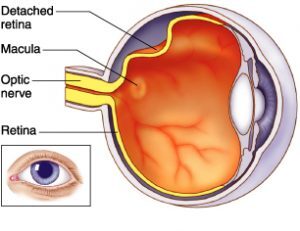Blog
Detached Retina

What is retinal detachment?
The retina is the light-sensing tissue in your eyes. It processes incoming light into signals that are sent through the optic nerve to your brain, which enables you to see images. Retinal detachment (detached retina) occurs when the retina comes lose from its normal position. Fluid make leak into the area underneath the retina, and there may be a tear or break in the retina.
What causes retinal detachment?
Retinal detachment is most common in people over age 40, in men more than women, and in whites more than African-Americans. It is more likely to occur if you:
- Have a family history of detached retina
- Had cataract surgery
- Had an eye injury
- Are extremely nearsighted
- Had a retinal detachment in your other eye
- Have certain eye diseases or disorders, such as uveitis, lattice degeneration, retinoschisis, or degenerative myopia
How do I know if I have a detached retina?
You may see an increase in the number of floaters—little cobwebs or specks that dart about in front of your eyes. Floaters are very common as you age. But if they are accompanied by flashes of light, seeing a “curtain” over your field of vision, or having a shadow appear in your peripheral (side) vision, you may have a detached retina. It is a medical emergency, so see an eye care professional immediately.
How is retinal detachment treated?
Treatments for retinal detachment are successful in 90 percent of patients, though sometimes a second treatment is needed. You’ll have the best outcome if you receive treatment before the macula (the central part of your retina) detaches. A detached retina may be repaired using one or more of these approaches:
- Laser surgery to “weld” the retina back into place.
- Cryopexy, which freezes the area around a hole or tear and helps reattach the retina.
- Scleral buckle, a tiny band attached to the outside of the eyeball to gently push the wall of the eye against the detached retina.
- Vitrectomy to remove the gel-like vitreous in your eye and replace it with gas, which pushes the retina back against the eye wall. As you heal, fluid gradually replaces the gas and refills the eye.
Source: The National Eye Institute (NEI)